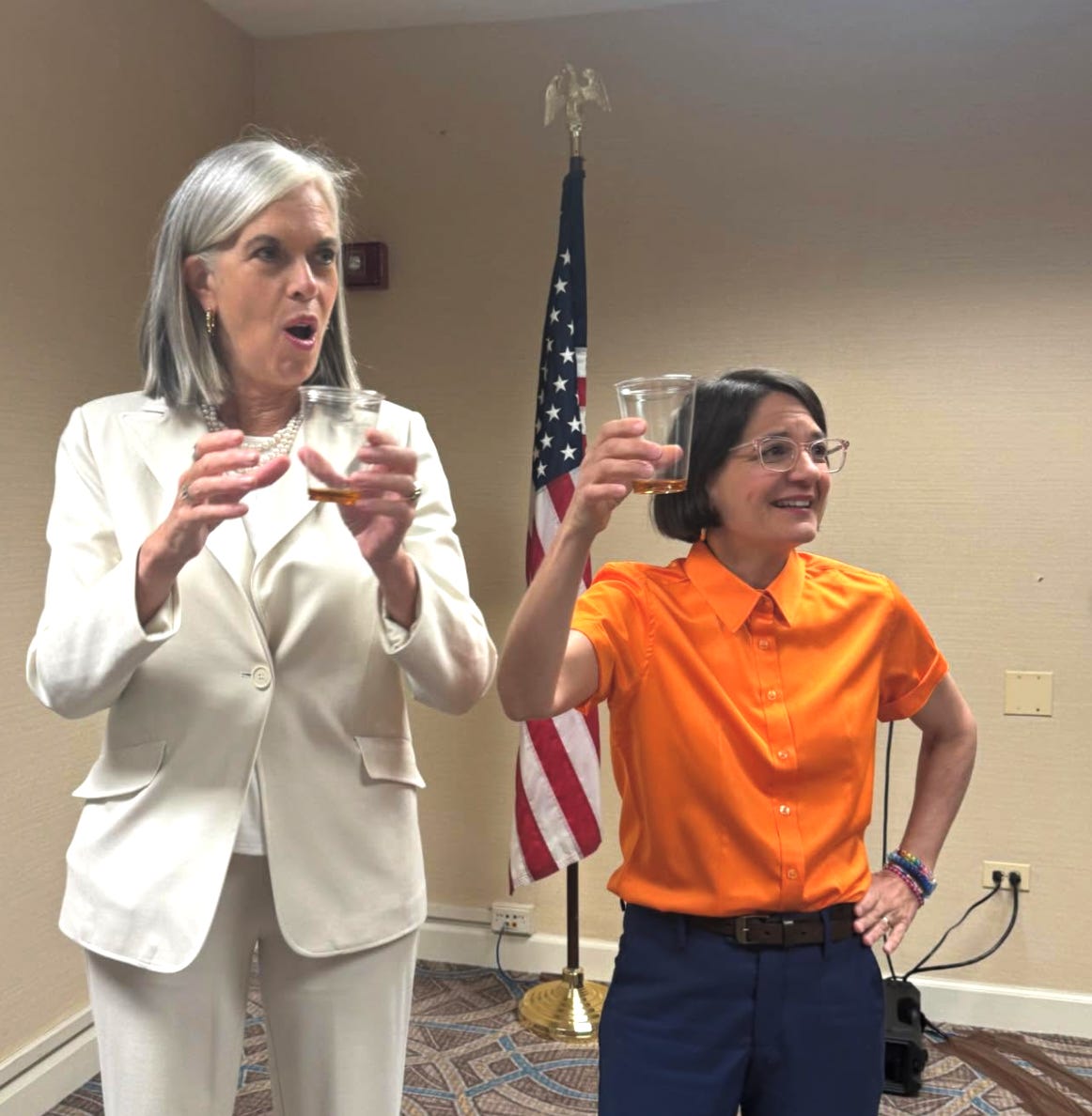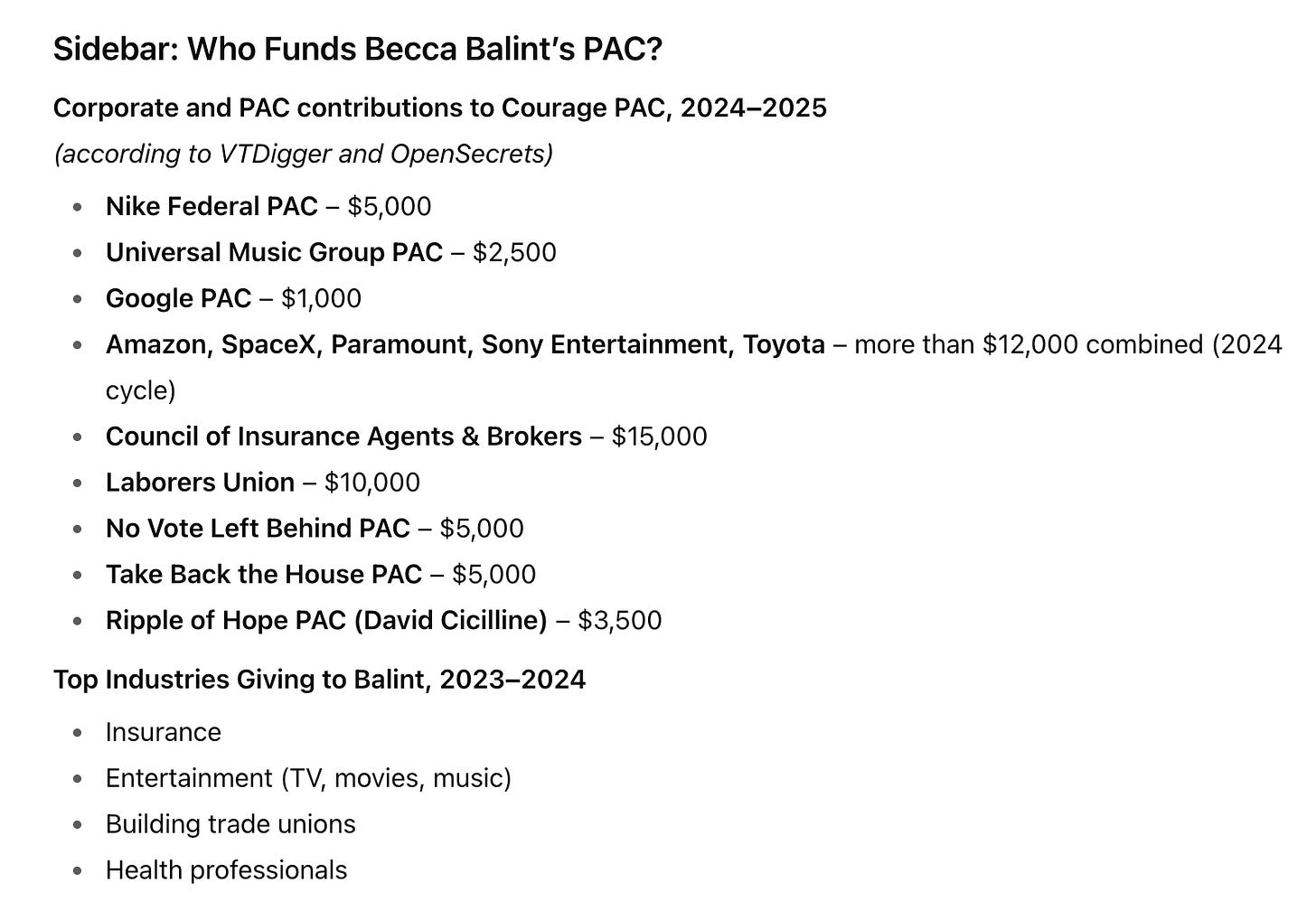Not Grounded in Vermont? Becca Balint’s PAC-Fueled Rise and What the State Really Needs
More and more Democrats are thinking Former Lieutenant Governor Molly Gray would be a more reliable member of Congress when it comes to representing Vermont.
A National Profile with a Local Cost
Vermont’s at-large congressional seat is unique. Representing the entire state with just one House member is no small responsibility—and Vermont deserves someone deeply rooted in its communities, not just focused on the national spotlight. Rep. Becca Balint, now in Washington, has carved a broader profile—but at what price to local needs?
The PAC Money Question: Not as Simple as It Sounds
Balint has told supporters that she does not take corporate PAC money. However, according to VTDigger, her leadership PAC—Courage PAC—accepted multiple contributions from corporate political action committees.
In addition, campaign finance records reviewed by OpenSecrets show Courage PAC’s largest donors from 2023–2024 included $15,000 from the Council of Insurance Agents & Brokers, $10,000 from the Laborers Union, and $5,000 each from No Vote Left Behind PAC and Take Back the House PAC.
These donations came even as Balint continued to tell Vermonters she was relying on grassroots donations and avoiding corporate PAC money. The reality, according to these disclosures, is more complicated.
The Bankman-Fried Connection
Balint’s 2022 campaign also drew heavy outside spending from a super PAC linked to the crypto industry. According to Seven Days and VTDigger, the LGBTQ Victory Fund’s super PAC spent nearly $1 million supporting Balint during the Democratic primary. Most of that money came from Nishad Singh, an FTX executive, and Sam Bankman-Fried, who is now in prison, contributed directly to Balint’s campaign.
Federal prosecutors later said in court that the donations were part of an illegal straw-donor scheme designed to disguise the true source of the money.
"We thought she'd at least give the million dollars back." - a supporter said after the scandal was revealed.
Red-Boxing and Texting: Campaign Tactics That Raised Eyebrows
Balint’s campaign was also one of the first in Vermont to adopt what critics consider aggressive tactics. According to Seven Days, her campaign used “red-boxing,” a practice where campaigns place coded instructions on their websites to guide super PACs in shaping ads. While technically legal, watchdogs say this blurs the line on coordination rules.
Balint also made widespread use of mass text-message fundraising and outreach. While standard in national races, according to reports in Vermont political coverage, the strategy left many residents irritated to receive unsolicited political texts from a candidate.
Policy Focus: Capitol Hill vs. Community Concerns
Balint’s committee assignments on Budget, Judiciary, and Oversight position her to work on sweeping national issues. According to congressional records, her work has emphasized democracy reform, corporate consolidation, and federal policy battles. Critics note that while these are important, Vermont continues to grapple with more immediate concerns—housing affordability, rural health care, and workforce shortages—which receive less attention in her public agenda.
Bernie Brought Home the Bacon
Vermont already has a national figure in Bernie Sanders. According to the Senator’s office, Sanders’s high profile has helped bring federal dollars and attention to Vermont for decades. But with only three seats in Congress, observers argue the state cannot afford to send another national-profile politician to Washington.
The What-If: Molly Gray
Former Lieutenant Governor Molly Gray was seen by many as the frontrunner for the House seat in 2022. According to Seven Days, Gray’s campaign was overwhelmed when outside PAC money supercharged Balint’s effort. Supporters of Gray have since argued that Vermont might have been better served by her more pragmatic and locally focused approach.
Conclusion: All Sizzle and No Steak?
Balint’s rise highlights Vermont’s enduring question: should its small delegation prioritize national branding or local problem-solving? According to campaign finance records, her leadership PAC has accepted large sums from corporate-affiliated donors despite her statements to the contrary.
According to Seven Days, her campaign used red-boxing, a tactic critics view as sidestepping campaign finance rules. And according to VTDigger, her PAC benefited from crypto money connected to a fraud scandal.
Taken together, these moves reinforce the perception that Vermont’s newest representative may be more of a performer than a producer. For a state that values authenticity and grounded leadership, the question remains whether that is what Vermont truly needs in Washington.





Republican or democrat, Vermont needs a person that helps Vermont thrive and not fill a politician’s war chest. I believe it time to put in a republican that can work on both sides. They are out there. I also believe Molly Gray should try again. Liberals, you are getting nowhere!
It's all about the Money, and that's a Shame....